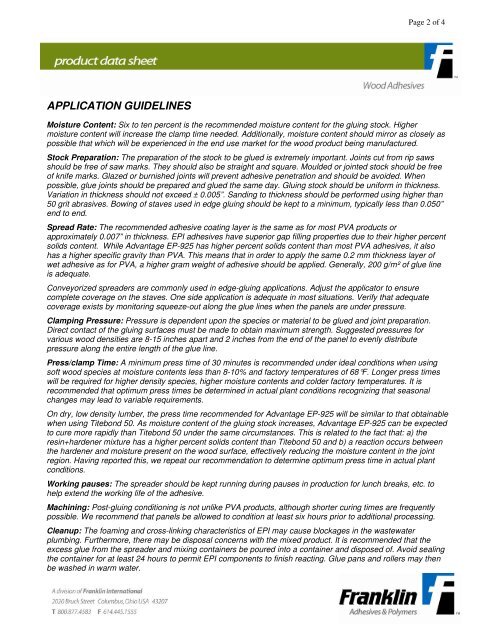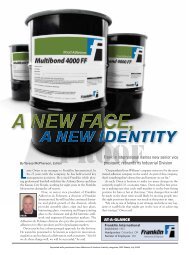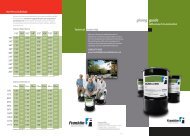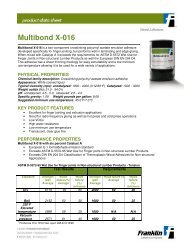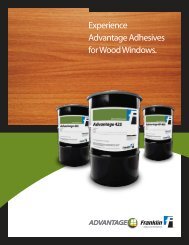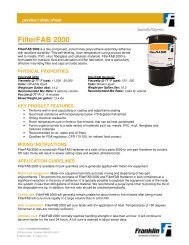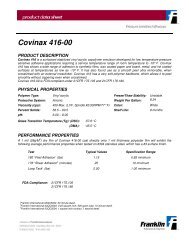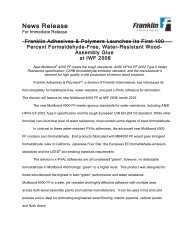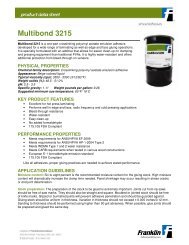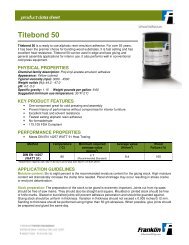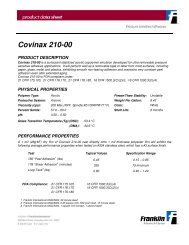Advantage EP-925 - Franklin Adhesives and Polymers
Advantage EP-925 - Franklin Adhesives and Polymers
Advantage EP-925 - Franklin Adhesives and Polymers
You also want an ePaper? Increase the reach of your titles
YUMPU automatically turns print PDFs into web optimized ePapers that Google loves.
Page 2 of 4<br />
APPLICATION GUIDELINES<br />
Moisture Content: Six to ten percent is the recommended moisture content for the gluing stock. Higher<br />
moisture content will increase the clamp time needed. Additionally, moisture content should mirror as closely as<br />
possible that which will be experienced in the end use market for the wood product being manufactured.<br />
Stock Preparation: The preparation of the stock to be glued is extremely important. Joints cut from rip saws<br />
should be free of saw marks. They should also be straight <strong>and</strong> square. Moulded or jointed stock should be free<br />
of knife marks. Glazed or burnished joints will prevent adhesive penetration <strong>and</strong> should be avoided. When<br />
possible, glue joints should be prepared <strong>and</strong> glued the same day. Gluing stock should be uniform in thickness.<br />
Variation in thickness should not exceed ± 0.005”. S<strong>and</strong>ing to thickness should be performed using higher than<br />
50 grit abrasives. Bowing of staves used in edge gluing should be kept to a minimum, typically less than 0.050”<br />
end to end.<br />
Spread Rate: The recommended adhesive coating layer is the same as for most PVA products or<br />
approximately 0.007” in thickness. <strong>EP</strong>I adhesives have superior gap filling properties due to their higher percent<br />
solids content. While <strong>Advantage</strong> <strong>EP</strong>-<strong>925</strong> has higher percent solids content than most PVA adhesives, it also<br />
has a higher specific gravity than PVA. This means that in order to apply the same 0.2 mm thickness layer of<br />
wet adhesive as for PVA, a higher gram weight of adhesive should be applied. Generally, 200 g/m² of glue line<br />
is adequate.<br />
Conveyorized spreaders are commonly used in edge-gluing applications. Adjust the applicator to ensure<br />
complete coverage on the staves. One side application is adequate in most situations. Verify that adequate<br />
coverage exists by monitoring squeeze-out along the glue lines when the panels are under pressure.<br />
Clamping Pressure: Pressure is dependent upon the species or material to be glued <strong>and</strong> joint preparation.<br />
Direct contact of the gluing surfaces must be made to obtain maximum strength. Suggested pressures for<br />
various wood densities are 8-15 inches apart <strong>and</strong> 2 inches from the end of the panel to evenly distribute<br />
pressure along the entire length of the glue line.<br />
Press/clamp Time: A minimum press time of 30 minutes is recommended under ideal conditions when using<br />
soft wood species at moisture contents less than 8-10% <strong>and</strong> factory temperatures of 68°F. Longer press times<br />
will be required for higher density species, higher moisture contents <strong>and</strong> colder factory temperatures. It is<br />
recommended that optimum press times be determined in actual plant conditions recognizing that seasonal<br />
changes may lead to variable requirements.<br />
On dry, low density lumber, the press time recommended for <strong>Advantage</strong> <strong>EP</strong>-<strong>925</strong> will be similar to that obtainable<br />
when using Titebond 50. As moisture content of the gluing stock increases, <strong>Advantage</strong> <strong>EP</strong>-<strong>925</strong> can be expected<br />
to cure more rapidly than Titebond 50 under the same circumstances. This is related to the fact that: a) the<br />
resin+hardener mixture has a higher percent solids content than Titebond 50 <strong>and</strong> b) a reaction occurs between<br />
the hardener <strong>and</strong> moisture present on the wood surface, effectively reducing the moisture content in the joint<br />
region. Having reported this, we repeat our recommendation to determine optimum press time in actual plant<br />
conditions.<br />
Working pauses: The spreader should be kept running during pauses in production for lunch breaks, etc. to<br />
help extend the working life of the adhesive.<br />
Machining: Post-gluing conditioning is not unlike PVA products, although shorter curing times are frequently<br />
possible. We recommend that panels be allowed to condition at least six hours prior to additional processing.<br />
Cleanup: The foaming <strong>and</strong> cross-linking characteristics of <strong>EP</strong>I may cause blockages in the wastewater<br />
plumbing. Furthermore, there may be disposal concerns with the mixed product. It is recommended that the<br />
excess glue from the spreader <strong>and</strong> mixing containers be poured into a container <strong>and</strong> disposed of. Avoid sealing<br />
the container for at least 24 hours to permit <strong>EP</strong>I components to finish reacting. Glue pans <strong>and</strong> rollers may then<br />
be washed in warm water.


